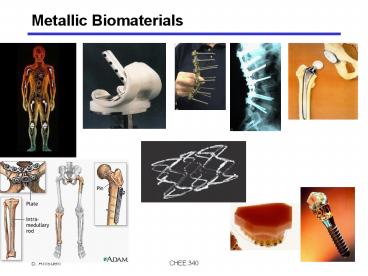Metallic Biomaterials - PowerPoint PPT Presentation
1 / 17
Title:
Metallic Biomaterials
Description:
The electrons in metals are mobile and surround a core of cations. ... are good conductors in an electrolyte solution, leading to galvanic corrosion. ... – PowerPoint PPT presentation
Number of Views:476
Avg rating:3.0/5.0
Title: Metallic Biomaterials
1
Metallic Biomaterials
2
Metals Are Crystalline
Body-Centered Cubic
The body-centered cubic (bcc) crystal structure
(a) hard-ball model (b) unit cell and (c)
single crystal with many unit cells. Source W.
G. Moffatt, et al., The Structure and Properties
of Materials, Vol. 1, John Wiley Sons, 1976.
3
Metal Bonding
- The electrons in metals are mobile and surround a
core of cations. This gives rise to their high
electrical conductivity.
4
Crystals and Grain Formation
5
Product Manufacture
- There are 4 main methods of metal product
manufacture - machining
- melt casting
- forging
- hot isostatic pressing
6
Influence of Manufacturing Process
Casting Defect
Polished-etched view of a cast ASTM F75 femoral
hip stem. Note dendrites and large grains
In vivo fracture initiated from an inclusion
formed during the casting process
From H. Alexander et al., Chapter 2,
Biomaterials Science, BD Ratner et al., Academic
Press, 1996.
7
Metallic Biomaterials
- There are 3 main groups of metals used as
biomaterials - stainless steels
- Co-based alloys
- titanium-based alloys
8
Design Considerations
- typically want to match mechanical properties of
tissue with mechanical properties of metal - have to consider how the metal may fail in vivo
- corrosion
- wear
- fatigue
- need to consider cost
9
Mechanical Properties
10
Corrosion
- The extra-cellular environment is a chemically
aggressive space. Metallic biomaterials are good
conductors in an electrolyte solution, leading to
galvanic corrosion.
11
Corrosion
12
Mechanisms of Corrosion
- Crevice Corrosion
- Pitting Corrosion
- Intergranular Corrosion
13
Mechanisms of Corrosion
- Fretting Corrosion Stress Corrosion Cracking
14
Mechanisms of Corrosion
Contribution of biological environment
From S.H. Teoh, International Journal of
Fatigue 22 (2000) 825837
15
Wear
- The effects of wear are most predominant in joint
prostheses. - There are two types of wear
- Interfacial Wear
- Fatigue Wear
16
Fatigue
- Recall that fatigue is progressive failure of a
material due to the application of cyclical
stresses below the ultimate stress of the
material causing crack propagation. - Crack usually starts at a stress concentrator or
stress riser. - Methods for reducing fatigue failure
17
Fatigue

